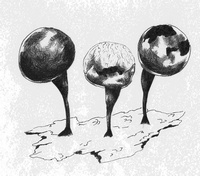|
 Lamproderma echinulatum Lamproderma echinulatum
SynonymsLamproderma listeri
Stemonitis echinulata
BiostatusPresent in region - Indigenous. Non endemic
Images (click to enlarge)
Caption: Three sporangia of Lamproderma echinulatum. Each sporangium is about 3 mm tall.
Owner: S.L. Stephenson |
Article: Stephenson, S.L. (2003). Myxomycetes of New Zealand. Fungi of New Zealand. Ngā Harore o Aotearoa 3: xiv + 238 p. Hong Kong: Fungal Diversity Press.
Description: Fruiting body a stalked sporangium, loosely clustered, total height 2–4 mm. Sporotheca globose to cylindrical-ovate, 0.5–1.0 mm in diameter. Stalk cylindrical or subulate, black, 1–3 mm long. Hypothallus discoid, dark brown. Peridium shining, steel blue with grey or green iridescence, membranous, persistent. Columella cylindrical, obtuse, reaching to about one–half the height of the sporotheca. Capillitium arising mainly from apex of columella, stout, sparingly forked and anastomosing, purplish brown, slender and colourless at the tips. Spores dark grey or brownish grey, with prominent long black spines, 15–20 µm in diameter. Plasmodium opaque white.
Habitat: Decaying wood, often with bryophytes present.
Distribution: DISTRIBUTION: Reported from widely scattered localities in North America, Europe, and Asia (Martin & Alexopoulos 1969). First reported (as Lamproderam listeri) from New Zealand by Massee (1892), but without giving a specific locality. Also known from Hawkes Bay (Colenso 1894), Fiordland, Dunedin (Rawson 1937), and the Snares Islands (Fineran 1969).
Notes: This species appears to be rare in most regions of the world but can be relatively common in some areas of Fiordland in late autumn. The large spores with long spines are distinctive.
|